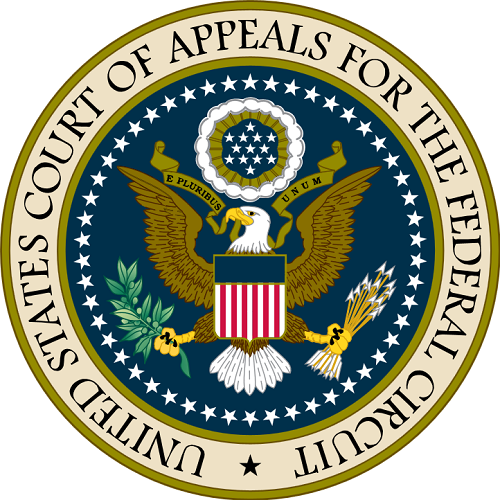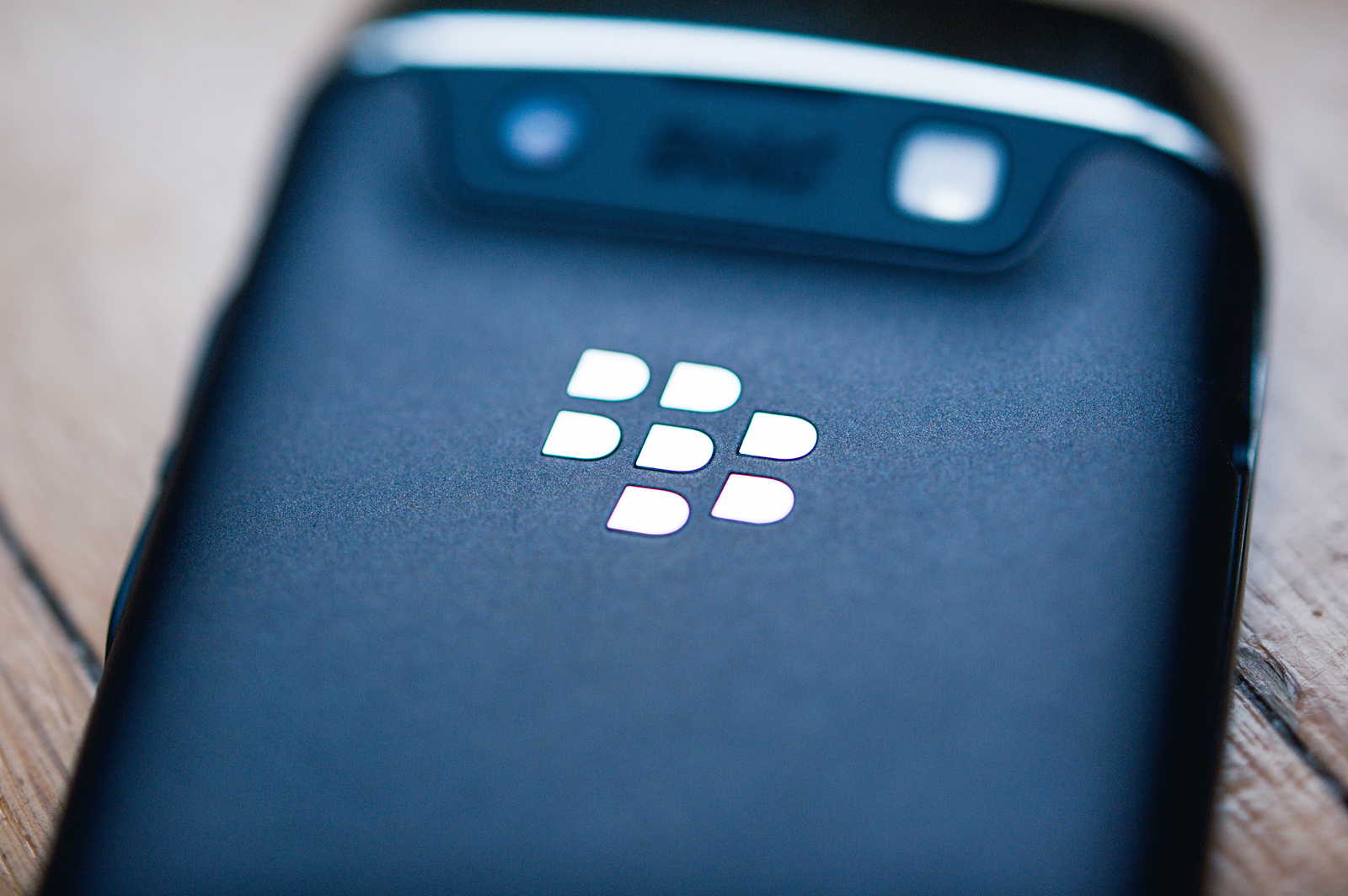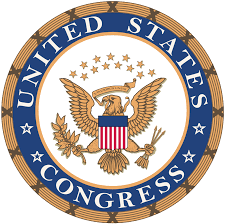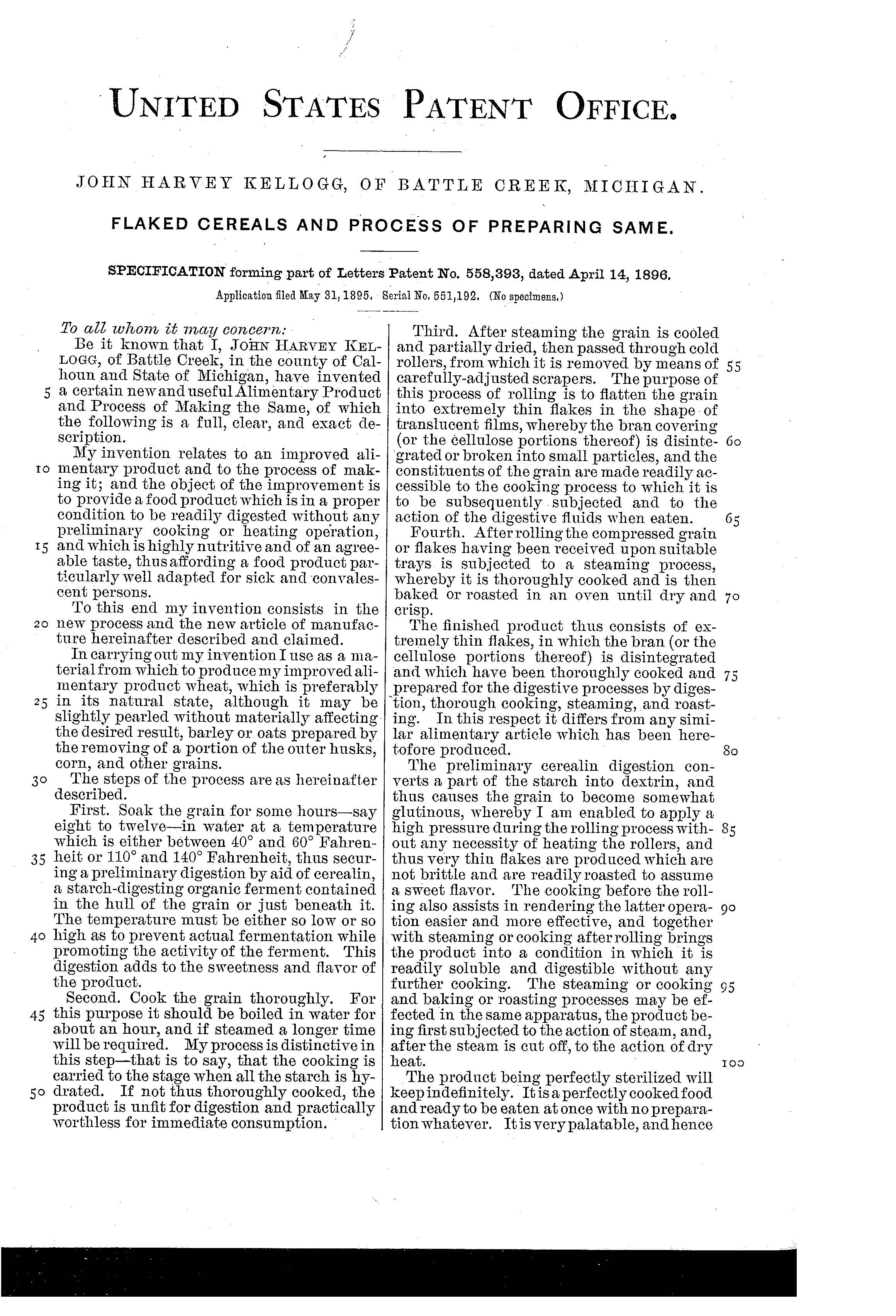Suiter Swantz IP Attorneys to Attend the AIPLA's 2018 Spring Meeting
Suiter Swantz IP attorneys Matt Poulsen and Faisal Abou-Nassr will attend this year’s American Intellectual Property Law Association’s (AIPLA) Spring Meeting, May 15 – 17 in Seattle, Washington.
This meeting will bring over 600 attendees from around the world. Matt and Faisal will have the opportunity to learn about the newest advancements and technologies being used in the field of intellectual property.
USPTO Director Iancu Wants to Change the Current Patent Dialogue
Andrei Iancu, director of the United States Patent and Trademark Office (USPTO), spoke at the U.S. Chamber of Commerce Patent Policy Conference on April 11th.
In his speech he noted that patents are part of the building blocks of innovation and technology. He spoke of Dr. Eli Harari, inventor of flash memory storage, and how without a patent Harari’s successful journey may have had a different, less fortunate, outcome. Harari told Iancu that your idea is your only asset. “If you have no way to protect your idea, you are at the mercy of the next bad guy.”
Iancu attested to the truth in Harari’s comments and stated “our patent system is at a crossroads…our system has been pushed and pulled, poked and prodded.” The result of this is a “system in which the patent grant is less reliable…we are at an inflection point with respect to the patent system. As a nation, we cannot continue down the same path.”
Iancu focused his speech on two key points: creating a new pro-innovation, pro-IP dialogue; and increasing the reliability of the patent grant.
Iancu wants to “change the dialogue surrounding patents.” While admitting there are errors in the system, Iancu stated they will be corrected, abuse will not be tolerated, and the current dialogue should move to a more positive one. The new narrative should define the “patent system by the brilliance of inventors, the excitement of invention, and the incredible benefits they bring to society.” This should be what drives patent policies. He asked those at the conference to reflect, and ask themselves if they are pushing progress forward are they “incentivizing innovation?”
Iancu stated that patent grant reliability is the key to “incentivizing innovation.” He went on to state that without reliable patents inventors are less likely to bring their ideas to the table. This lack of confidence in the granting of patents will lead to a further drop in the U.S.’ patent systems rankings.
The Chamber issued a report identifying the two main reasons for the increased uncertainty of patents: patentability standards, specifically, “patent subject matter eligibility pursuant to 35 USC Section 101;” and opposition procedures, specifically IPR and post-grant proceedings established by the American Invents Act (AIA).
Iancu addressed the report and stated he feels the current laws on patentable subject matter “have created a more unpredictable patent landscape that is hurting innovation and, consequently, investment and job creation.” Recent Supreme Court cases have inserted ambiguous interpretations of statutes that lead to inconsistent rulings by lower courts. He said the Supreme Court law will be applied “faithfully” but this “does not mean, however, that more cannot be done to increase clarity and predictability.”
In regard to post-grant and IPR proceedings, Iancu believes people should view the process “with fresh eyes, in order to understand its true benefits and true challenges…We need to carefully balance rights-holder’s and rights challenger’s interests.”
Iancu touched on the issue of predictability and said “we must ensure that we issue appropriately-scoped patent claims from the get-go.” He focused on the importance of examiners and ways to help increase their effectiveness by increasing their “ability to find the best prior art during examination.”
Iancu closed by stating “[w]e must work together to achieve a careful balance that is most beneficial to the American economy as a whole. In the end, the hallmarks of a well-functioning patent system are the reliability and predictability of quality patents. This is critical for both patent holders and the public.”
Suiter Swantz IP is a full-service intellectual property law firm, based in Omaha, NE, serving all of Nebraska, Iowa, and South Dakota. If you have any intellectual property questions or need assistance with your patent, trademark, or copyright matters and would like to speak with one of our patent attorneys please contact us.
CAFC Grants Stay to St. Regis Mohawk Tribe in Sovereign Immunity Case
On Wednesday March 28, 2018, the United States Court of Appeals for the Federal Circuit (CAFC) granted the St. Regis Mohawk Tribe a stay. The motion for the stay pertains to the inter partes review proceedings before the Patent Trial and Appeal Board (PTAB) and the St. Regis Mohawk Tribe’s partnership with pharmaceutical giant Allergan (St. Regis Mohawk Tribe v. Mylan Pharmaceuticals Inc.).
The clash between the two companies began when Allergan partnered with the Saint Regis Mohawk Tribe, a sovereign Indian nation. This partnership involved the transfer of six patents that cover the company’s top-selling drug Restasis. This unprecedented move by Allergan could potentially allow them to avoid IPR proceedings in the PTAB due to the Tribe’s sovereign immunity status.
The Tribe asserted its sovereign immunity status by filing a motion to dismiss the multiple IPR proceedings only to have the motion denied. The PTAB stated “we determine the Tribe has not established that the doctrine of tribal sovereign immunity should be applied to these proceedings.”
Following the denial of the motion the Tribe filed an appeal with the CAFC, in addition to seeking a stay from the PTAB. The PTAB denied the stay and moved for a final hearing. This hearing will no longer happen as the CAFC “sua sponte expedited briefing on the merits and scheduled oral arguments for June 2018.”
The CAFC ordered:
Appellants’ motion for a stay is granted until the day after oral argument in June 2018. At this juncture, it appears that the appeals divested the Board of jurisdiction over the aspects of the case on appeal, see Griggs v. Provident Consumer Discount Co., 459 U.S. 56, 58 (1982); Princz v. Fed. Republic of Ger., 998 F.2d 1 (D.C. Cir. 1993) (appeal from denial of motion to dismiss on grounds of sovereign immunity divests district court of jurisdiction over entire case); Apostol v. Gallion, 870 F.2d 1335 (7th Cir. 1989); accord In re Graves, 69 F.3d 1147, 1149 (Fed. Cir. 1995), and that exclusive jurisdiction to resolve the threshold issue of whether these proceedings must be terminated vests in this court, and that the Board may not proceed until granted leave by this court. The stay shall remain in effect until the day after oral argument in the appeals in June 2018. The court will address whether the stay shall remain in effect or whether it will be lifted at that time based on further consideration of the merits of the appeals.
This controversial case has garnered attention from all directions including Senator Claire McCaskill (D-MO) who introduced a bill that was centered around closing the “brazen loophole” this deal may have caused.
It is worth noting that a Native American Tribe is not the first group to use sovereign immunity to bypass IPR proceedings. The University of Florida Research Foundation (UFRF) had three IPR proceedings ended after they asserted their sovereign status over Covidien LP. The PTAB stated public research universities have some protection from IPR proceedings afforded to them under the 11th Amendment.
Suiter Swantz IP is a full-service intellectual property law firm, based in Omaha, NE, serving all of Nebraska, Iowa, and South Dakota. If you have any intellectual property questions or need assistance with any patent, trademark, or copyright matters and would like to speak with one of our patent attorneys please contact us.
Patent of the Week: Spatial Logical Toy (Rubik's Cube)
On March 29, 1983, Ernö Rubik was granted the patent for SPATIAL LOGICAL TOY, U.S. Patent No. 4,378,116.
The spatial logic toy, known today as the Rubik’s Cube, was first introduced in 1974 in Hungary by inventor Ernö Rubik. Rubik, a professor at the Academy of Applied Arts and Design, spent a lot of his free time designing puzzles to create a different way of thinking about three-dimensional geometry.
One of these designs was a wooden cube, each side contained nine moveable squares, and each side had a specific color. Rubik started out enjoying how the squares moved but after a certain amount of time he realized he did not know how to get the squares aligned back to their original side and color. It took him over a month to figured it out, he said “it was a code I myself had invented! Yet I could not read it.” The cube has over 43 quintillion combinations in which it can be rearranged.
This toy was designed to stimulate logical thinking in teenagers. According to the application “the object of the invention is to develop a spatial logical toy, which is built up of a total of eighteen toy elements forming a solid (a regular or amorphous body), preferably a rectangular solid shaped body, in the assembled state, while the toy elements are mutually connected in the center of the solid without using separate connecting profiles, merely by the proper shape of the solids of the toy elements. Along the spatial axes of the spatial logical toy, six or nine toy elements can be simultaneously rotated, yielding the possibility of several variations of play.”
By 1979, the cube was ready to be mass produced and introduced to the United States. Prior to its launch in the U.S., Ideal Toys decided a name change would be better for marketing and trademark protection. Originally called the Magic Cube, the company debated many names but eventually settled on Rubik’s Cube. By 1982, over 100 million cubes had been sold and that is also the year the International Rubik’s Championships were held; a competition to see who could solve the puzzle the fastest. The winner of that competition solved the toy puzzle in 22.95 seconds.
More than 350 million Rubik’s Cubes have been sold worldwide and it is noted as one of the best-selling toys of all times.
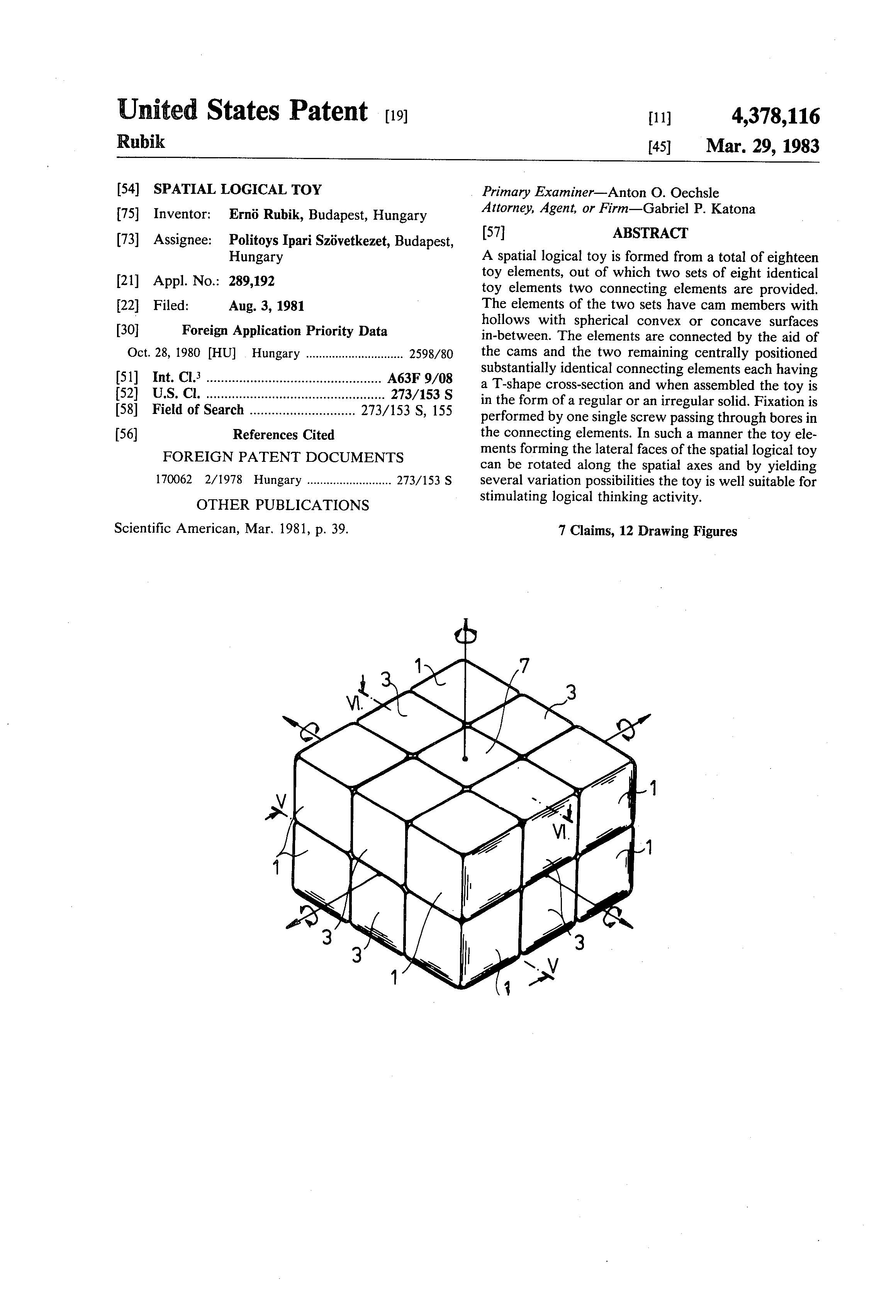
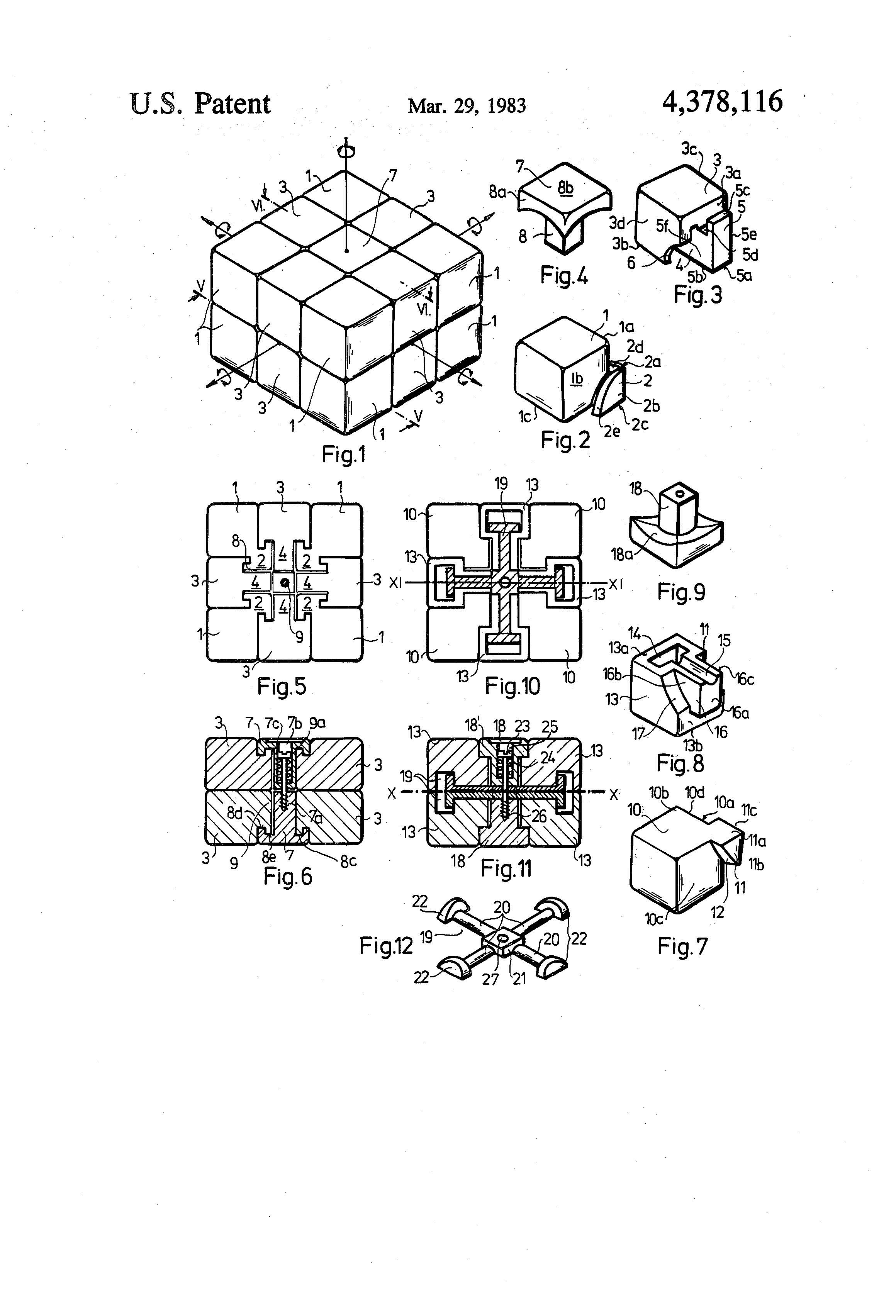
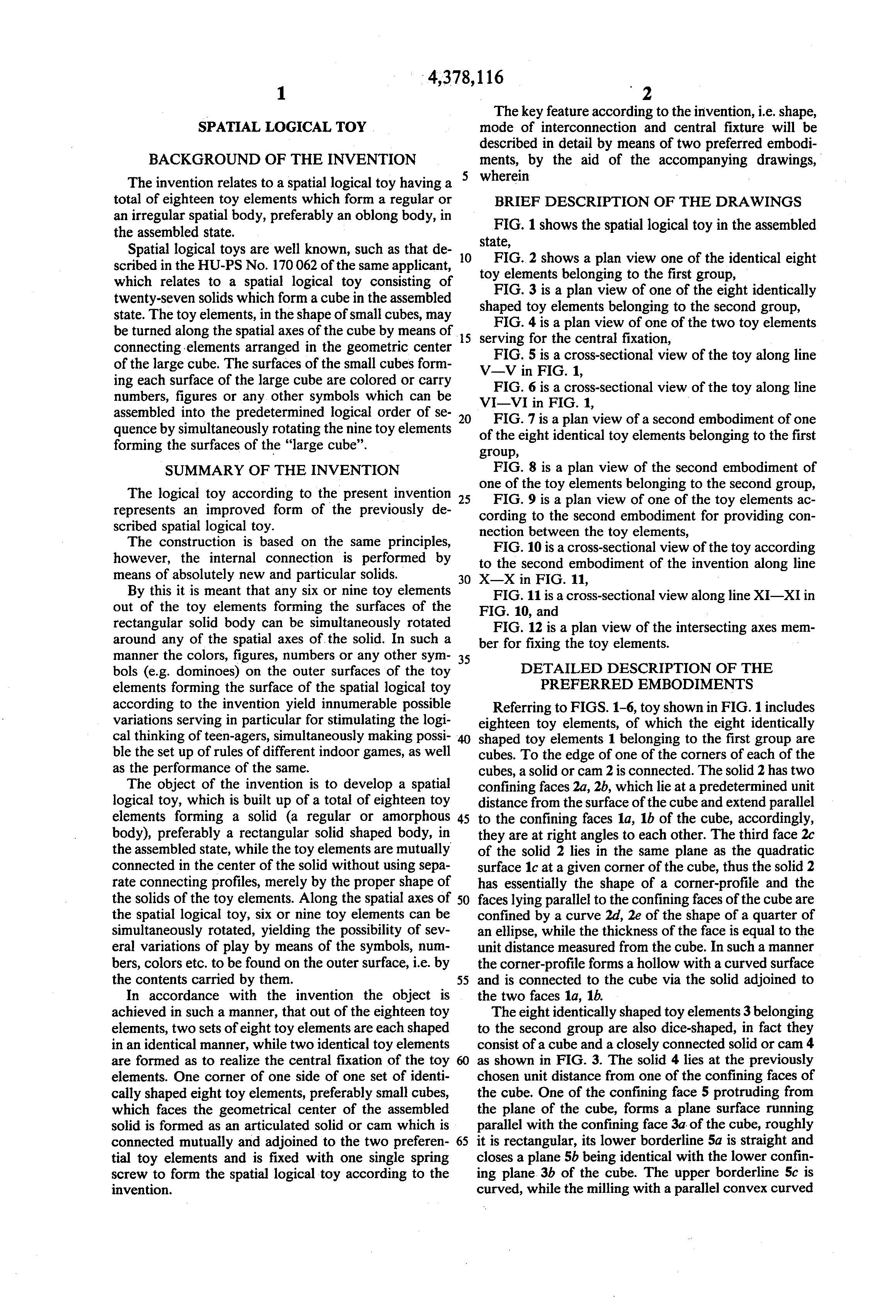
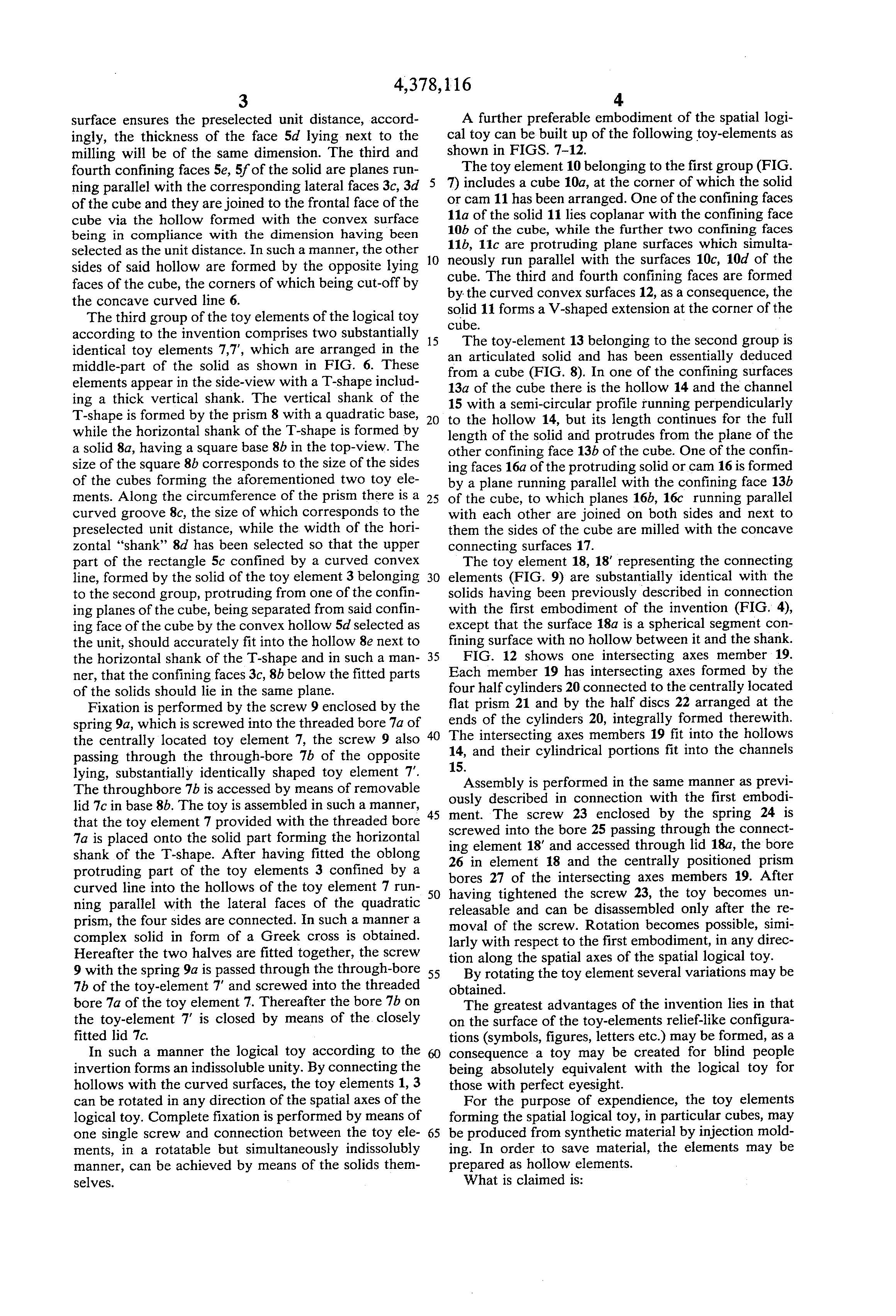
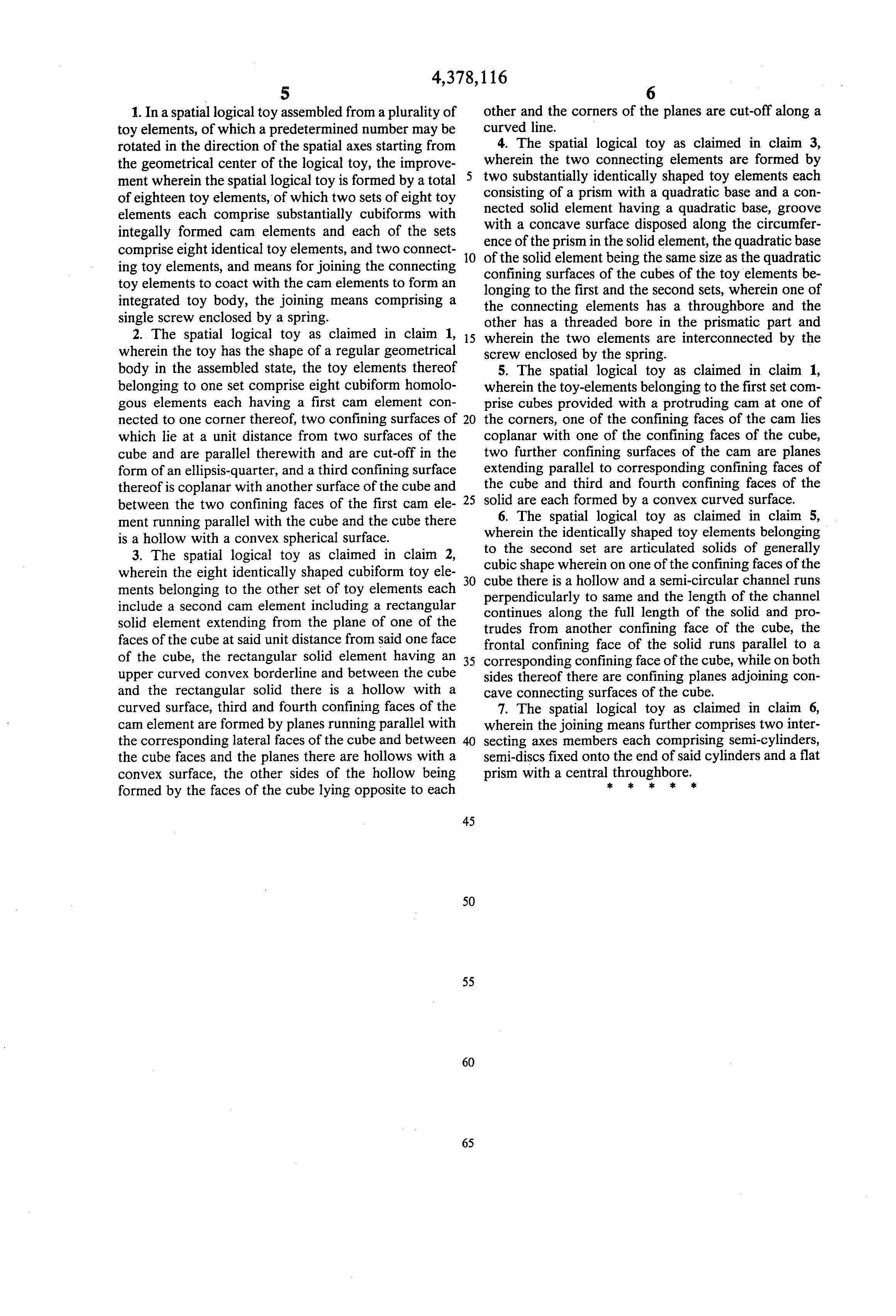
Suiter Swantz IP is a full-service intellectual property law firm, based in Omaha, NE, serving all of Nebraska, Iowa, and South Dakota. If you have any intellectual property questions or need assistance with any patent, trademark, or copyright matters and would like to speak with one of our patent attorneys please contact us.
BlackBerry Sues Facebook for Patent Infringement
Close to a decade ago BlackBerry was one of the most popular mobile phone providers. BlackBerrys were known for their signature rollerball, keyboard, and BlackBerry messenger (BBM); functions diehard BlackBerry users still miss. Now, BlackBerry is in the business of providing business software and services, among other things, to large corporations and government entities.
BlackBerry recently made headlines by suing Facebook regarding its Instagram and WhatsApp platforms over messaging technology that BlackBerry is alleging they invented years ago.
Before messaging services and apps became popular, BlackBerry had BBM, one of the first forms of instant communication. Users could instantly share content such as videos and images, form chat groups, receive and send unlimited messages as well as receive live confirmations when messages are sent, received and viewed.
According to BlackBerry, this lawsuit has been a long time coming and is something Facebook should have expected. The two companies have had open dialogues about negotiations on this issue for years. According to BlackBerry, Facebook “created mobile messaging applications that co-opt BlackBerry’s innovations, using a number of the innovative security, user interface, and functionality enhancing features.” Sarah McKinney, spokeswoman for BlackBerry, stated “[p]rotecting shareholder assets and intellectual property is the job of every CEO.” McKinney did note, however, that litigation was “not central to BlackBerry’s strategy.”
This is not the first lawsuit BlackBerry has instituted over technologies they hold patents on. The company has over 40,000 patents globally covering cybersecurity, wireless communication, operating systems and network infrastructures, to name a few. The company has also begun testing the waters with cybersecurity software programs for autonomous vehicles. Blackberry is wanting companies to pay licensing royalties over these technologies, a move some have referred to as “trolling”.
A representative for BlackBerry commented that their company has "a lot of respect for Facebook and the value they've placed on messaging capabilities, some of which were invented by BlackBerry. As a cybersecurity and embedded software leader, BlackBerry's view is that Facebook, Instagram, and WhatsApp could make great partners in our drive toward a securely connected future, and we continue to hold this door open to them.”
Paul Grewal, deputy general counsel for Facebook, does not share the same sentiment, stating, "Blackberry's suit sadly reflects the current state of its messaging business. Having abandoned its efforts to innovate, Blackberry is now looking to tax the innovation of others. We intend to fight."
BlackBerry has settled many lawsuits over their patented technologies, some of which with large companies like Cisco, Avaya, Qualcomm, and phone manufacturer Blu Products. Most of these cases settled out of court but it will be interesting to see how Facebook proceeds as they are a large corporation that has the financial means to see this move to trial.
Suiter Swantz IP is a full-service intellectual property law firm, based in Omaha, NE, serving all of Nebraska, Iowa, and South Dakota. If you have any intellectual property questions or need assistance with any patent, trademark, or copyright matters and would like to speak with one of our patent attorneys please contact us.
Patent of the Week: Method and System for Placing a Purchase Order Via a Communication Network
On September 28, 1999, inventors Peri Hartman, Jeffrey P. Bezos, Shel Kaphan, and Joel Speigel were granted the patent for METHOD AND SYSTEM FOR PLACING A PURCHASE ORDER VIA A COMMUNICATIONS NETWORK, U.S. Patent No. 5,960,411. This 1-click system is used when ordering items off the shopping platform Amazon.com.
Amazon did not start out as the online shopping giant it is today. It began in 1994 with Jeff Bezos, and an idea to sell books online to anyone anywhere. At the time of Amazon’s incorporation Bezos was met with a lot of uncertainty over his company with critics claiming big retailers such as Borders and Barnes and Noble would knock him out of the market.
Fortunately, for Bezos, he did not listen to his critics; instead, he stuck with his motto of “Get Big Fast” and that’s what he did. In just four years from incorporation Amazon went from $15.7 million in revenue to $610 million. The company launched an Associates program, where other websites could sell their merchandise on Amazon.com; Amazon filled the order and paid a commission. From there Amazon’s online shopping presence began; they sold electronics, video games, home improvement items, toys and more.
Amazon took the company public in 1997 and generated $54 million on the NASDAQ. With the growth of the company they were able to offer more goods for purchase online in addition to a more personalized website that implemented recommendations based on previous purchases, customer reviews of an item, and the patented 1-click ordering system.
The 1-click method was an innovative concept at the time. The user entered their payment information and the information was stored so there was no need for it to be entered every time an order was placed. This 1-click method has become the new standard for most online retailers today.
Suiter Swantz IP is a full-service intellectual property law firm, based in Omaha, NE, serving all of Nebraska, Iowa, and South Dakota. If you have any intellectual property questions or need assistance with any patent, trademark, or copyright matters and would like to speak with one of our patent attorneys please contact us.
STRONGER Patents Act Introduced in House
On March 22, 2018, Rep. Steve Stivers (R-OH) and Rep. Bill Foster (D-IL) introduced the Support Technology & Research for Our Nation’s Growth and Economic Resilience (STRONGER) Patents Act into the House of Representatives.
The proposed bill accompanies the previous bill of the same name that was introduced in June of 2017, by Senator Chris Coons (D-Del.). Coons introduced the Support Technology & Research for Our Nation’s Growth and Economic Resilience Act (the STRONGER Patents Act), which is intended to make it easier and more affordable for patent holders to enforce their patents.
The current bill aims to “strengthen the position of the United States as the world’s leading innovator by amending title 35, United States Code, to protect the property rights of the inventors that grow the country’s economy.”
A few specific goals of the bill are to limit repeat patent validity challenges, ensure fairness in administrative challenges, protect small business owners from abusive patent demand letters, and to ensure the United States Patent Office (USPTO) retains fees collected for patent application and other patent prosecution matters.
The new bill also identifies the unintended consequences of the enactment of the 2011, American Invents Act (AIA). One such consequence of the AIA are the negative aspects associated with the post-grant review proceedings at the Patent Trial and Appeal Board (PTAB). The AIA attempted to provide a more efficient administrative process to eliminate “bad” patents. In reality, the implementation of procedures such as inter partes review (IPR) proceedings has caused the duplicitous filing of petitions in the PTAB by challenging parties and has created more work and has led to more fees, which some feel is akin to extortion. Many have referred to the PTAB as the death squad. Rep. Stivers stated “[i]nstead of [the PTAB] living up to its billing as being more efficient and quicker, the PTAB has become just another stop which is more complicated, more expensive and exactly the opposite of what it was intended to do.”
One aspect of the STRONGER patents bill is it would modify the claim construction procedure in IPR and other post-grant proceedings and would require claims in these venues to be construed as they would be under Section 282(b). The requirements for PTAB petitions would also be strengthened by requiring initiating parties to show: a possibility of an infringement suit, a charge of infringement of the challenged patent, or a demonstration of “competitive harm related to the validity of the patent.”
In addition, the new bill proposes new IPR amendment practices, which would allow a patent owner to propose a reasonable number of substitute claims which would be examined in an expedited process.
Other provisions in Title I increase the opportunity to request a reexamination, if submitted in writing and accompanied by the reexamination fee. An ex parte reexamination may be barred if filed a year or more after the infringement complaint is served. Title I also provides improvements in the courts’ ability to issue injunctions when patent infringement is determined; gives institutions of higher education micro-entity status; ensures that USPTO fees are not diverted, and assists small businesses through the patent system.
Provisions in Title II focus on targeting rogue and opaque letters, such as letters sent in bad faith by patent owners with misleading statements about actions to be taken. The Federal Trade Commission (FTC) and State Attorneys General (AG) are given the power to bring suit against entities engaging in bad faith communications for their perspective jurisdictions—for the AGs, this title preempts state laws relating to communications pertaining to patent rights assertions.
There have been multiple Supreme Court and legislative changes over the past decade that many feel have resulted in the weakening of the patent system. Historically, the United States was ranked first in the world for innovation and protection of intellectual property. According to the U.S. Chamber of Commerce’s international ranking of patent system strength, the UK and Germany are quickly rising to the top of the list, while the United States has markedly fallen.
Rep Stivers commented, “[h]istorically, since Edison and even before, we have had the best ideas and intellectual property system in the world. Those things together created the world’s greatest economy. If we don’t have a strong IP system, it will hurt our economy.”
As with all things political, there are those with opinions on both sides of the issue. However, the STRONGER Act has largely been met with strong bipartisan support.
Suiter Swantz IP is a full-service intellectual property law firm, based in Omaha, NE, serving all of Nebraska, Iowa, and South Dakota. If you have any intellectual property questions or need assistance with any patent, trademark, or copyright matters and would like to speak with one of our patent attorneys please contact us.
Office Hours April 11 at the Brookings, SD Office
Suiter Swantz IP will hold office hours at our Brookings, SD satellite office located in the South Dakota State University Research Park on April 11th.
Feel free to send Matt Poulsen an email (map@suiter.com) if you’d like to reserve a time to meet or have any questions.
Suiter Swantz IP
402-496-0300
www.suiter.com
Matt Poulsen to Judge New Venture Competition
Suiter Swantz IP attorney Matt Poulsen will serve as a judge at the 2018 UNL New Venture Competition held April 3 -4 at the Nebraska Union.
The New Venture Competition is a celebration of entrepreneurial learning and competition. Undergraduate and graduate students from all majors will pitch their business plan to a panel of judges from the Lincoln and Omaha business community and field questions on current traction, monetization strategies, risky assumptions, and more. They will also compete for over $75,000 in total prize money.
Patent of the Week: Flaked Cereals and Process of Preparing the Same (Corn Flakes)
On April 14, 1896, John Harvey Kellogg was granted the patent for FLAKED CEREALS AND PROCESS OF PREPARING THE SAME, U.S. Patent No. 558,393.
Cereal is one of those inventions that was discovered by accident. John Kellogg and his brother William, were Seventh-day Adventist and adhered to a strict bland vegetarian diet. The brothers worked for a sanitarium John, the superintendent, and William the business manager. The two were trying to come up with a healthy snack for the patients and attempted to make a form of bread that was easily digestible. The brothers rolled out some dough, accidentally forgot about it, and it hardened. With a limited food budget, they tried to make the dough work and ran it through rollers. Fortunately, that accident led to the first flaked cereal, known today as Corn Flakes.
John went on to patent the process for making such cereal. The application states the invention “relates to an improved alimentary product and to the process of making it; and the object of the Improvement is to provide a food product which is in a proper condition to be readily digested without any preliminary cooking or heating operation, and which is highly nutritive and of an agreeable taste.”
The cereal was a hit with the patients at the sanitarium, those that left even requested it. The cereal’s popularity grew and the brothers began to package it, sell it, and ship it. In 1906 William opened the Battle Creek Toasted Corn Flake Company and with his brothers help they worked on getting their cereal out to the masses. Unfortunately, the brothers parted ways when William wanted to add sugar to the cereal to make it more palatable for a larger audience. John, adhering to the strict diet and beliefs that sugar and other substances would increase bad behavior couldn’t support the addition of sugar and left.
Suiter Swantz IP is a full-service intellectual property law firm, based in Omaha, NE, serving all of Nebraska, Iowa, and South Dakota. If you have any intellectual property questions or need assistance with any patent, trademark, or copyright matters and would like to speak with one of our patent attorneys please contact us.
Guidance for Functional Language in Apparatus Claims to Avoid Indefiniteness
On October 2017, the United States Court of Appeals for the Federal Circuit (CAFC) issued a precedential opinion in Mastermine Software, Inc. v. Microsoft Corp. The CAFC reversed the indefiniteness determination of the United States District Court for the District of Minnesota regarding claims 1, 8 10 and 12 of U.S. Patent No. 7,945,850 and claims 1, 2, and 3 of U.S. Patent No. 8,429,518. The CAFC declared, “these claims are simply apparatus claims with proper functional language.”
This dispute originated with Mastermine Software, Inc. asserting Microsoft Corp. infringed four claims of U.S. Patents No. 7,945,850 and three claims of No. 8,429,518 in the District of Minnesota. Issues regarding claim construction involving “pivot tables” and claim indefiniteness arose. After unfavorable rulings, Mastermine appealed.
On appeal, the CAFC concluded the district court had properly construed “pivot table” but reversed the court’s indefiniteness determination. In a discussion regarding indefiniteness of the claims, the CAFC referenced IPXL Holdings, L.L.C. v. Amazon.com, Inc., a case of first impression, where the CAFC held that a single claim covering both an apparatus and a method of use of that apparatus is indefinite under section 112, paragraph 2. The CAFC expressed concern in IPXL Holdings that claiming both an apparatus and method of using the apparatus within a single claim can make it “unclear whether infringement . . . occurs when one creates a[n infringing] system, or whether infringement occurs when the user actually uses [the system in an infringing manner].”
Further discussion by the CAFC regarding indefiniteness of the Mastermine claims referenced UltimatePointer, LLC v. Nintendo Co., where the claims at issue claimed: “‘a handheld device including: an image sensor, said image sensor generating data’ and other similar ‘generating data’ limitations.” The CAFC held these claims in UltimatePointer were unlike those in IPXL Holdings because they “make clear that the ‘generating data’ limitation reflects the capability of that structure rather than the activities of the user,” and “do not reflect an attempt to claim both an apparatus and a method, but instead claim an apparatus with particular capabilities.”
The CAFC viewed the Mastermine claims as being similar to, among other cases, UltimatePointer. The district court focused its analysis, inter alia, on claim 8 of the ’850 patent, which discloses in pertinent part,
“[a] system comprising”:
. . . .
a reporting module installed within the CRM software application . . . ;
. . . .
wherein the reporting module installed within the CRM software application presents a set of user selectable database fields as a function of the selected report template, receives from the user a selection of one or more of the user-selectable database fields, and generates a database query as a function of the user selected database fields; . . . .
The CAFC stated, “[t]hough claim 8 includes active verbs—presents, receives, and generates—these verbs represent permissible functional language used to describe capabilities of the “reporting module.”
The CAFC was concerned in IPXL Holdings that claiming both an apparatus and a method of using the apparatus with a single claim can make it “unclear whether infringement . . . occurs when one creates a[n infringing] system, or whether infringement occurs when the user actually uses [the system in an infringing manner].” The CAFC declared, “[t]he claims at issue here [in Mastermine] do not pose this problem. Because the claims merely use permissible functional language to describe the capabilities of the claimed system, it is clear that infringement occurs when one makes, uses, offers to sell, or sells the claimed system.”
A takeaway lesson to apply when drafting apparatus claims with functional language is to recite that actions are carried out by the apparatus rather than reciting actions are carried out by another device or a user.
Suiter Swantz IP is a full-service intellectual property firm, based in Omaha, NE, serving all of Nebraska, Iowa, and South Dakota. If you have any intellectual property questions or need assistance with any patent, trademark, or copyright matters and would like to speak to one of our attorneys please contact us.
Tinder Swipes Left by Suing Bumble
Gone are the days of meeting people “the old-fashioned way.” Online dating has now become the preferred choice of many for meeting people. With such a highly competitive market, it is unsurprising that lawsuits should arise. Match Group, LLC, the wholly-owned subsidiary to Match Group, Inc., and owner of popular dating sites such as Match, Plenty of Fish, OKCupid, and flagship brand Tinder, is suing Bumble, a dating app, for patent infringement.
Tinder is the dating app known for its famous swipeable cards that contain an image and details about a possible match. The app will locate possible matches based on the geographical proximity of the user to another Tinder user. A swipe right means the user is interested, a swipe left means the user is uninterested and the card will not show up again. If two users both swipe right on each other they can chat with each other through the app.
Tinder’s app was carefully constructed. Tinder has multiple utility and design patents, such as U.S. Patent No. 9,733,811, U.S. Patent No. D798,314, and U.S. Patent No. D781,311, the app has a trademark for the swipe mark, as well as copyright protection.
Another popular online dating app, Bumble, founded by previous Tinder employees, Chris Gulczynski and Sarah Mick, lets users swipe left and right, similar to Tinder, but allows users to go back if they accidentally swiped left on a person, a function Tinder does not have. Bumble also requires female users to initiate conversations if pursuing an opposite gender relationship; another feature Tinder not have but is in the works of implementing.
Many of Bumble’s features have been described as being similar to Tinder’s features with TechCrunch describing Bumble’s app as “almost identical to Tinder, complete with the design of the profile pages, settings, and swipe functionality.”
In the lawsuit, Match Group alleged Bumble “copied Tinder’s world-changing, card-swipe-based, mutual opt-in premise” and feel Bumble is “virtually identical” to Tinder. The lawsuit further alleged that Bumble’s founders implemented two features that were being secretly developed at Tinder indicating a breach in their confidentiality agreement. Match stated this case is “not about any Bumble personnel’s personal history with anyone previously at Tinder” rather it is about “forcing Bumble to stop competing with Match and Tinder using Match’s own inventions, patented designs, trademarks, and trade secrets.”
Bumble was founded in 2014 and since its inception it has become one of the most popular online dating sites around. According to Forbes, Bumble has more than 22 million followers and was expected to generate over $100 million in revenue in 2017.
In 2016, Match contacted Bumble and offered to buy the competing online dating company for $450 million. At that time Bumble refused the offer. Some believe Match bringing this lawsuit may be a bargaining chip to get Bumble to reconsider the offer. There would no longer be a need for a lawsuit if Bumble was acquired by Match Group.
A spokesperson for Match released the following statement:
Match Group has invested significant resources and creative expertise in the development of our industry-leading suite of products. We are committed to protecting the intellectual property and proprietary data that defines our business. Accordingly, we are prepared when necessary to enforce our patents and other intellectual property rights against any operator in the dating space who infringes upon those rights.
It will be interesting to see if the court swipes right or left on this case.



